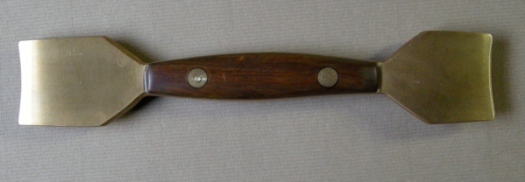
#1, a grattoir. I made this one based on an image in Diderot’s Encyclopedie. I think it should be all iron.
#2, a grattoir. I made this based on an image in Dudin’s Relieur. Traditional ones are iron and wood.
#3, a frottoir. Wood handle with iron. It resembles a fishtail chisel in profile and is similar to the older form of #2.
#4, a combination frottoir/grattoir. Likely French, has enormous, sharp teeth.
#5, a combination frottoir/grattoir.nLikely French. Smaller teeth but larger overall.
#6, a froittoir. I based this one on models similar to #4 and #5 above. I use brass because I don’t want to risk rusting paper. It can be purchased in my shop.
#7, a froittoir. Looks vaguely German to me. It is very light. Generally, a German style frottoir is much thicker, and used perpendicularly to the spine-folds, rather than parallel, so I’m still searching for information about this one.
#8, a froittoir. Looks to mid-20th century to me, and is in clean, working condition. A great story accompanied this one via Jan Camps. J and J Camps. Jan relates that it was from the workshop Mr. Volkaerts, from Mechelen (a town in Flanders between Brussels and Antwerp). He studied bookbinding in La Cambre in Brussels. He got married, and for some reason his wife forbade him to start his own studio, instead he spent his whole life working a day job as a government official. In his spare time he bound books and managed to form a huge collection of gilding tools. After his death, his wife sold the books, stored away his machines and his collection of gilding tools. After she her heirs sold these boxes to Jan.
#9, a froittoir. Similar to #8 but older, much heavier, and much more comfortable to use. This could also be of German origin, Peter Verheyen mentioned to me it is called a called a Cachiereisen/ Cachier-Eisen /Kaschiereisen/Kaschier-Eisen.
#10, a froittoir. Old wood, wonderfully heavy and a great patina. This shape is very interesting to me, especially the offset “foot”. I would like to see how it is traditionally used.
#11, a froittoir. Heavy wood and beautiful curve. The presence on paint or stain on both #10 and #11 suggest they might have been used for leather marbling or edge sprinkling.
#12, a froittoir A modern, lighter beech version of #10 and #11. J and J Camps bought it in an antique market “place de jeu de balles” in Brussels.
#13, a froittoir. I wondered if a smaller wood one could work as well as a iron one. It doesn’t. Based on a shape found in Dudin’s Relieur, though I think the original was iron.
#14, a froittoir. Currently sold by TALAS. I find it useless because the ends are too rounded and the handle is too straight to comfortably hold, and the pores in the wood absorb too much paste. However, a similar one is pictured in Edith Diehl’s 1946 Bookbinding: Its Background and Technique, p. 142.
_________________________
Note: I acquired numbers 3, 4, 5, 7, 9, 10, 11 from J and J Camps in 2016. According to him, they originally belonged to Renatus De Cock, a binder in Mechelen. A biography of De Cock, in Dutch, but with pictures is here (http://www.boekbinderij-camps.be/content/files/111-229-engramzine-r-de-cock-af0cc7.pdf). De Cock studied bookbinding and gilding in Brussels at “Institut des Arts et Métiers de la Ville de Bruxelles”, his teacher was Louis Malcorps. De Cock bought some old workshops when he was a student and in the beginning of his career, the frottoirs/grattoirs where part of these workshops and likely date from around 1900 or earlier.



